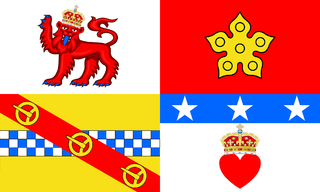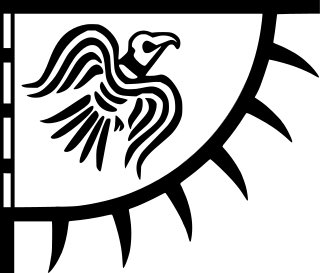Related Research Articles
Causantín mac Cináeda was a king of the Picts. He is often known as Constantine I in reference to his place in modern lists of Scottish monarchs, but contemporary sources described Causantín only as a Pictish king. A son of Cináed mac Ailpín, he succeeded his uncle Domnall mac Ailpín as Pictish king following the latter's death on 13 April 862. It is likely that Causantín's reign witnessed increased activity by Vikings, based in Ireland, Northumbria and northern Britain. He died fighting one such invasion.

Causantín mac Áeda was an early King of Scotland, known then by the Gaelic name Alba. The Kingdom of Alba, a name which first appears in Constantine's lifetime, was situated in modern-day Northern Scotland.
Macbethad mac Findláech, nicknamed the Red King, was King of Scotland (Alba) from 1040 until his death. Little is known about Macbeth's early life, although he was the son of Findláech of Moray and may have been a grandson of Malcolm II. He became Mormaer (Earl) of Moray – a semi-autonomous province – in 1032, and was probably responsible for the death of the previous mormaer, Gille Coemgáin. He subsequently married Gille Coemgáin's widow, Gruoch, but they had no children together.

Máel Coluim mac Domnaill was king of Alba, becoming king when his cousin Constantine II abdicated to become a monk. He was the son of Donald II.
Cináed mac Maíl Coluim was King of Alba (Scotland) from 971 to 995. The son of Malcolm I, he succeeded King Cuilén on the latter's death at the hands of Rhydderch ap Dyfnwal in 971.
Constantine, son of Cuilén, known in most modern regnal lists as Constantine III, was king of Alba (Scotland) from 995 to 997. He was the son of King Cuilén. John of Fordun calls him, in Latin, Constantinus Calvus, which translates to Constantine the Bald. Benjamin Hudson notes that insular authors from Ireland and Scotland typically identified rulers by sobriquets, noting for example the similarly named Eugenius Calvus, an 11th-century King of Strathclyde.

Atholl or Athole is a large historical division in the Scottish Highlands, bordering Marr, Badenoch, Lochaber, Breadalbane, Strathearn, Perth, and Gowrie. Historically it was a Pictish kingdom, becoming one of the original provinces of the Kingdom of Alba before being incorporated into the sheriffdom and later county of Perthshire. Today it forms the northern part of Perth and Kinross, Scotland.
In early medieval Scotland, a mormaer was the Gaelic name for a regional or provincial ruler, theoretically second only to the King of Scots, and the senior of a Toísech (chieftain). Mormaers were equivalent to English earls or Continental counts, and the term is often translated into English as 'earl'.

The Mormaer or Earl of Angus was the ruler of the medieval Scottish province of Angus. The title, in the Peerage of Scotland, is held by the Duke of Hamilton, and is used as a courtesy title for the eldest son of the Duke's eldest son.
Gille Brigte of Angus is one of the earliest attested Mormaers of Angus. He was possibly a descendant of Dubacan of Angus.
Moray was a province within the area of modern-day Scotland, that may at times up to the 12th century have operated as an independent kingdom or as a power base for competing claimants to the Kingdom of Alba. It covered a much larger territory than the modern council area of Moray, extending approximately from the River Spey in the east to the River Beauly in the north, and encompassing Badenoch, Lochaber and Glenelg in the south and west.
Findláech mac Ruaidrí, son of Ruaidrí mac Donald, was the minor "king", locally called "Mormaer", of Moray, in the north of modern-day Scotland, from some point before 1014 until his death in 1020. Findláech's son Macbethad mac Findláech, was made famous as the protagonist of William Shakespeare's play Macbeth.
The House of Moray or Clann Ruaidrí is a historiographical and genealogical construct to illustrate the succession of rulers whose base was in Moray and who ruled sometimes a larger kingdom. An important feature of Scottish politics throughout the 11th century, they reached the height of their power with the reign of Macbeth between 1040 and 1057.

Fortriu was a Pictish kingdom recorded between the 4th and 10th centuries. It was traditionally believed to be located in and around Strathearn in central Scotland, but is more likely to have been based in the north, in the Moray and Easter Ross area. Fortriu is a term used by historians as it is not known what name its people used to refer to their polity. Historians also sometimes use the name synonymously with Pictland in general.

The Kingdom of Alba was the Kingdom of Scotland between the deaths of Donald II in 900 and of Alexander III in 1286. The latter's death led indirectly to an invasion of Scotland by Edward I of England in 1296 and the First War of Scottish Independence.
Cuncar of Angus was Mormaer of Angus somewhere in the mid or later 10th century, which makes it quite possible that he was the successor of Dubacan. One divergent source calls him thanus, but otherwise he is comes. The tradition called by Anderson the Chronicle of the Kings of Scotland records in several manuscripts that Cuncar's daughter Lady Finella was responsible for the death of king Cináed II, because the aforementioned King of Scots had put her son to death. Otherwise, Cuncar is obscure. Even the name "Cuncar" is obscure, and may not be authentic, representing either the Gaelic name Conchobar or the Brythonic name Cincar. John of Fordun calls him Cruchne, which is clearly equivalent to Cruithne, as in Fordun's period, owing to French influence, cs often replace ts. Cruithne was the Gaelic word for a Pict, but why Fordun gives Cuncar this name is even more obscure than Cuncar himself.

The High Middle Ages of Scotland encompass Scotland in the era between the death of Domnall II in 900 AD and the death of King Alexander III in 1286, which was an indirect cause of the Wars of Scottish Independence.
The MacHeths were a Celtic kindred who raised several rebellions against the kings of Scotland in the 12th and 13th centuries. Their origins have long been debated.

The Mormaer of Caithness was a vassal title mostly held by members of the Norwegian nobility based in Orkney from the Viking Age until 1350. The mormaerdom was held as fief of Scotland and the title was frequently held by the Norse Earls of Orkney, who were thus a vassal of both the King of Norway and the King of Scots. There is no other example in the history of either Norway or of Scotland in which a dynasty of earls owed their allegiance to two different kings.
The Provinces of Scotland were the primary subdivisions of the early Kingdom of Alba, first recorded in the 10th century and probably developing from earlier Pictish territories. Provinces were led by a mormaer, the leader of the most powerful provincial kin-group, and had military, fiscal and judicial functions. Their high degree of local autonomy made them important regional powerbases for competing claimants to the throne of Alba.
References
- ↑ Woolf 2007, p. 175.
- ↑ Woolf 2007, p. 126.
- ↑ Woolf 2007, p. 204.